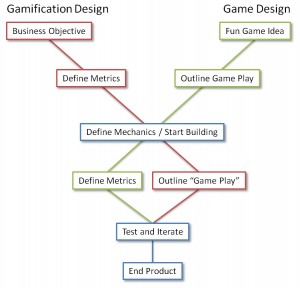Trending
Opinion: How will Project 2025 impact game developers?
The Heritage Foundation's manifesto for the possible next administration could do great harm to many, including large portions of the game development community.

Featured Blog | This community-written post highlights the best of what the game industry has to offer. Read more like it on the Game Developer Blogs or learn how to Submit Your Own Blog Post
It is no secret that I would love to get the games industry to become more involved in gamification and have spoken to many people in the industry about it.

It is no secret that I would love to get the games industry to become more involved in gamification and have spoken to many people in the industry about it. Ian Bogost refered to my original plea as a “gentle form of terrorism” saying that it was like me saying to the games industry
If you don’t like me crapping on your shoes, then teach me how to use the toilet.
However, generally there is a feeling that there is a middle ground, but that it may be too hard to find for it to be beneficial to anyone.
This got me to thinking why? Then it hit me, it is all in the purpose of design. I know this should have been obvious, but I can be slow at times.
As well as designing gamified concepts, I also dabble in game design. My wildly popular game Cops ‘n’ Robbers was a huge hit in my living room in the early part of 2000. I have made little games that some of you have played here and am in the process of creating a card game with the help of my 7 year old daughter. With this in mind, I have a pretty good vision of both design processes and they are pretty different in parts.
When creating a game, you tend to start with a basic idea. It may just be a theme you wish to explore, it could be an interesting mechanic you want to flesh out into a full game or you could have the whole game in your head start to finish. However the idea starts life, you pursue it because you think it will be enjoyable for you or others to play.
You then start to put the idea together into something coherent. You prototype the basic mechanics and game-play elements.
Next you experiment with how they fit together, why dynamics appear out of what combinations. You work out the themes and the story. Basically you put the meat on the bones of game, then the polish.
Along the way, depending on how you want to manage the game, you will consider collecting metrics from the game. This may be part of a continual improvement plan, it may be part of a monetisation plan.
Eventually after play testing and multiple iterations you have a final game ready for the mass population to play.
You measure the success by how much people enjoy the game. Depending on the scale of the game, you will also have to measure sales.
When creating a gamified system, you start with an objective. This may be employee engagement, it may be increasing sales of a product. However, the goal is to meet that objective.
Next, depending on how you feel you can best meet that objective, you start to design your system. First and foremost in many systems will be the metrics you need to collect. The metrics are what will allow you to know if you are on target to meet the objective or not.
You consider what gamification elements and mechanics will best help you achieve the goal and start to put them into your system.
You will probably take into account how different user types react to different elements and experiment with them on test groups of users. Using the metrics you are collecting you will balance the system to drive the best and most efficient results you can.
After multiple iterations you release the product.
You measure success by how many people reach your original objective.
At least this is how all game designers think we do things – sadly in many cases, they are right.
It looks from this like there is no middle ground at all. Game design starts from the desire to make something that people will enjoy. In Gamification design, you are making something that will achieve a particular goal.
In game design, metrics are not always a main focus of a game – at least at the initial conception. In gamification design, metrics are what your system will live and die for.
In game design you use mechanics, themes and more to help to make the game more enjoyable. In gamification design you add things that will help drive the user towards your business objective.
 Gamification design vs Game Design
Gamification design vs Game Design
However, I still feel that there is a commonality. Whilst it seems the goals are mutually exclusive, they may not be in reality. Game design does have an objective – the objective is to create a game that is enjoyable, even if it is only you who finds it so. So everything you do is driven by this goal. You add and remove ideas as you find they work or don’t work.
Gamification design is no different. The goal may not be “fun”, but it is to make something less difficult or tedious to do. Gamification is often about lowering a barrier to achievement in some way.
Working together, we could re-align parts of the journey. Yes, the reason for creating a gamified system will always be different to creating a game as will the general process. However, there is no reason we can’t meet in the middle and maybe push mechanics and gameplay design a little higher in the minds of gamifiers.
Read more about:
Featured BlogsYou May Also Like